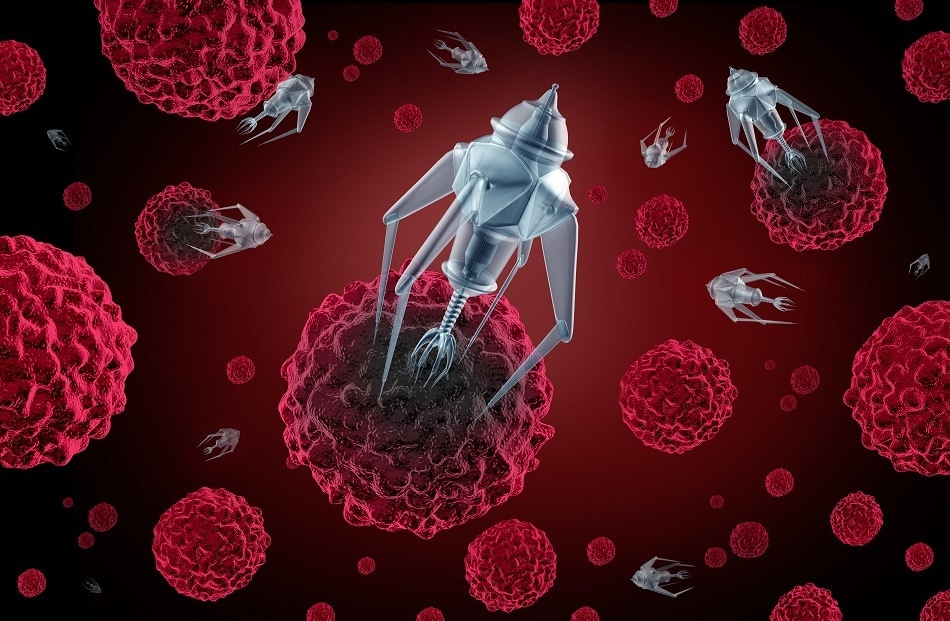
Image Credits: Lightspring/shutterstock.com
Robotics and nanotechnology go hand-in-hand as a mode of revolutionizing the modern world. Nanorobotics is the technology of creating machines or robots that are incredibly small – 10-9 m in fact – which could be used in a variety of ways.
Nanotechnology is an essential branch of modern science and electronics, and the more we learn about it the more interesting it becomes. It could solve some of the world’s biggest problems by bringing “sustainable development for materials, water, energy, and food, to protect against unknown bacteria and viruses,” said the National Science Foundation.
There are endless applications for nanorobotics, including in cancer treatments to identify and destroy cancer cells accurately and effectively, in drug delivery mechanisms, medical imaging and in information storage devices to name but a few.
These cell-sized robots could feature propulsion systems, sensors, manipulators and even onboard computers to help them perform a task on nanoscale items. Nanorobots might be built directly from atoms or molecules using mechanosynthesis or using current biological components such as proteins which can already move around the body and perform tasks such as cleaving defective portions of a DNA strand.
In Industry
Nanotechnology is ideal for industrial robotics, for example, where it is used to manipulate and build tiny devices no bigger than a group of molecules precisely at the atomic level. The objects typically range in size from 0.1-10 µm and are so small that it’s impossible for the human eye to see – nanotechnology becomes that necessary vision.
Robotics for nanotechnology allows the production of various items and operations. For example:
- Nanopositioning robots are used in fiber optic component assembly.
- Nanotech robots are used in the high-density pharmaceutical assay process.
- Robotic nano-manipulators are integrated into high-power scanning electron microscopes.
- Pick and place operations for building optical systems like spectrometers.
In the latter example, employing pick and place robots permits the production of miniaturized mass spectrometers that could be utilized at airports for instance in security and baggage screening. In this setting, a conventional mass spectrometer would be too large, but robotics with nanotechnology capabilities allows the technology to be scaled-down to a much more suitable size.
Employing robotics in nanotechnology also allows for the production of semiconductors and other tiny electronics. Robots deal with three different scales:
- Miniature: production consists of items like disc drives, mobile phones, and photonics.
- Micro: reached the level of sub-semiconductors and placing subassembly components onto chips themselves.
- Nano-scale.
Robotics are used in the manufacture of Micro-Electro-Mechanical Systems or MEMS, a process technology utilized to create tiny integrated devices or systems that combine mechanical and electrical components. This will include circuit board production as well as other nanosized components. MEMS robotics create integrated accelerometers, a constituent of airbags in cars; these minuscule accelerometers have flexing beams and sensors to detect deceleration to deploy the airbag.
MEMS products are also used in the medical arena, in angioplasty for example where surgical actuators can be shrunk and used to clean plaque from veins and arteries, or by placing a camera in a pill which can be swallowed to allow the digestive tract to be observed.
In the Home
Nanotechnology is also being using increasingly for robotics in the home, for developing smaller, faster computers, robot vacuum cleaners, smart home hubs and smartphones, and better cameras. It has transformed the way homeowners interact with everyday objects within their abode and has allowed devices to the shrunk to a more convenient size while also increasing performance and intelligence capabilities.
Furthermore, robotics in nanotechnology has many used in the military and medical settings and has transformed warfare and surgery. For example, the technology can be used in medical imaging; nanoparticles that gather in certain tissues and then scanning the body with a magnetic resonance imaging (MRI) could help highlight problems such as diabetes or in health sensors that could monitor our blood chemistry, advise us when something is not quite right, or detect inflammation in the body.
Conclusion
Robotics in nanotechnology has the ability to change the way were interact with the world around us, but there are still many unexplored options; the future is bright for this area of research.
Sources and Further Reading
Disclaimer: The views expressed here are those of the author expressed in their private capacity and do not necessarily represent the views of AZoM.com Limited T/A AZoNetwork the owner and operator of this website. This disclaimer forms part of the Terms and conditions of use of this website.